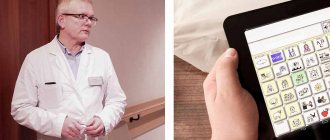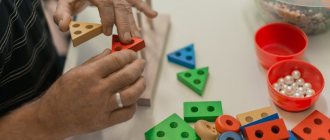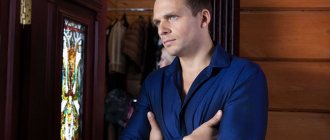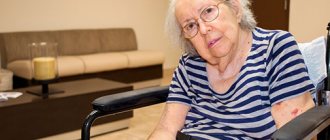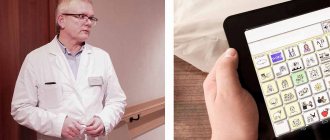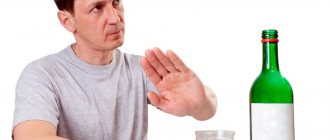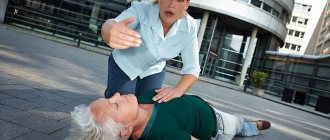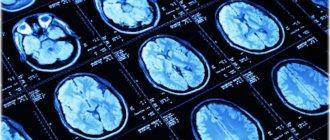Useful articles
Stroke is a lesion of the central nervous system that develops as a result of a significant disruption of cerebral circulation. There are 2 types of strokes – ischemic and hemorrhagic. Ischemia is caused by blockage or prolonged spasm of the cerebral arteries. The hemorrhagic form is a consequence of hemorrhage due to rupture of a vessel. Ischemic stroke can develop gradually, while hemorrhagic stroke is characterized by a sharp increase in symptoms. Common causes of pathology are atherosclerotic changes in blood vessels and a significant increase in pressure (in particular, with hypertension). Recovery after a stroke on the left side is recommended to take place in specialized rehabilitation centers under the supervision of experienced specialists.
How long do they live after pathology?
The least life-threatening is the so-called micro-stroke - during it, the patient’s blood supply in the basin of a small cerebral artery is disrupted, which can be restored on its own. In acute ischemic stroke, oxygen starvation occurs in a larger area of the left or right hemisphere, therefore, the consequences will be more serious. The most severe is a hemorrhagic stroke - in it, blood permeates the brain matter with the appearance of a hematoma.
Stroke has become “younger” - it often occurs in people aged 35-45 years.
The prognosis for survival after a stroke is highly dependent on the age of the patient and the severity of the pathology. Up to 45 years of age, mortality does not exceed 25%; most patients die due to extensive cerebral hemorrhages due to trauma and rupture of aneurysms. After 50 years of age, mortality exceeds 40-45%; in women, the disease often ends in failure. After 70-80 years, only 20% of people survive, but full recovery is impossible, the consequences are as follows:
Advertising:
- paralysis;
- change in mental abilities;
- worsening of chronic diseases;
- recurrent stroke.
After an attack, many live 10 years or more; at a young age, with quality treatment, life expectancy is common among their peers. But negative prognoses are also not uncommon - in 30% of survivors, death occurs in the first year after the initial attack. After repeated attacks, the average life expectancy is usually no more than 2-4 years, this is due to the persistence of risk factors - a tendency to develop blood clots, atherosclerosis, hypertension.
Epilepsy is a dangerous disease that is accompanied by severe seizures and loss of consciousness. You can manage its symptoms at home, but sometimes hospital treatment is necessary. Read more in the article: “treatment of epilepsy at home.”
What does recovery depend on?
Factors that reduce the chance of recovery:
- Diseases of the joints of a dystrophic nature;
- Inability to feel your own body;
- Disorders of consciousness and thinking;
- The degree of muscle hypotonia;
- The severity of damage to certain brain structures.
The patient’s complete recovery depends not only on timely assistance and correctly prescribed therapy, but also on how good care is provided. If a person is immobilized due to paralysis, then bedsore prevention is mandatory to avoid deterioration of the general condition and infection. Massage begins from the first days of treatment. The diet must be properly formulated so that the patient receives all the necessary nutrients. If independent food intake is not possible, the patient is fed through a special tube. Moral support and attention from medical staff and relatives are very important. The victim’s apathy or depression should not be perceived as a conscious refusal to help.
Clinical Brain Institute Rating: 3/5 — 2 votes
Share article on social networks
What influences the consequences of the disease?
Complications are most serious in elderly patients. There are many reasons, besides natural wear and tear of tissues and organs:
- hypertension that responds poorly to treatment;
- the presence of arrhythmia and coronary heart disease;
- high cholesterol;
- chronic kidney diseases, etc.
That is why in people over 60-70 years of age, a stroke often ends in coma and death, the disease progresses aggressively, affects brain tissue faster and covers large areas. At a young age, the ability to recover is higher, but a number of factors worsen the prognosis:
Advertising:
- hypertension;
- diabetes;
- obesity;
- vascular and heart diseases;
- prolonged stress;
- pregnancy;
- taking hormonal contraceptives.
With extensive hemorrhage or ischemia, the cells suffer so much that even after a year they cannot recover. Due to improper functioning of the brain, there is a predisposition to a repeated attack. The larger the affected area, the higher the risk of paralysis, mental disorders, and edema. Paralysis and immobile position of the body also aggravate the consequences - bedsores, kidney and lung diseases, and infections occur.
Abdominal pain occurs no less often in adults than in children. There are many reasons for this phenomenon, some of them quite serious. Colic and its treatment Colic is understood as an acute, sharp pain in the abdomen or side, which occurs in the form of spasms. Read more in the article: “stomach colic in adults.”
Early complications of stroke
The most serious consequences are caused by a stroke on the left side of the brain, since in most people it is more developed. Depending on the affected hemisphere, the opposite side of the body suffers - with a stroke on the right side of the brain, the consequences affect the left side of the body, and vice versa.
Most often, an attack occurs in the first half of the day or before waking up.
At an early stage, headaches, numbness of the face and limbs, and speech disorders may be noted. Vision deteriorates, an arm or leg or both limbs do not work. The consequences for the patient at first are as follows:
Advertising:
| Sign | Meaning |
| High blood pressure | The body's attempt to restore blood circulation can lead to brain swelling and recurrent stroke. |
| Temperature rise | Bad symptom, increases risk of death by 1/3 |
| Inhibition of reactions | Damage to the corresponding brain centers on the right or left side |
| Convulsions | More typical for hemorrhagic stroke |
| Rapid paralysis | The larger the affected area, the higher the risk of loss of motor functions |
Already in the first hours after the attack, a person often becomes deaf, loses vision, and an arm or leg becomes paralyzed. Memory is lost completely or partially. Speech impairments are more typical for left-sided lesions. If a large part of the brain is attacked, coma occurs. The best prognosis for emerging from a coma is for people with preserved reflexes, including swallowing, who remain in this state for no more than an hour. Also, at an early stage, a serious consequence is cerebral edema - swelling of its glial tissue due to soaking in fluid.
Recovery after a left-sided stroke
The right hemisphere may help restore speech after a left-sided stroke
April 1, 2021 Medscape Medical News, Neurology Sue Hughes
A new study has supported the idea that the right side of the brain is important for speech recovery after left-sided strokes . And this provides new opportunities for the rehabilitation of patients who have suffered a stroke. This study was published March 30. Conducted by a team led by Gottfried Schlaug, MD, of Harvard Medical School in Boston, Massachusetts.
"Our results suggest that the more damage was done to the left hemisphere of the brain, the more the right hemisphere was activated," he told Medscape Medical News. “It seems that nature itself helps restore lost functions. We hope to use this by increasing the impact on the right side of the brain.”
Thus, studies are currently underway that should prove the positive effect of treatment with music and singing while stimulating the right hemisphere. Data will be published later.
As background, the study authors explain that aphasia is a common and devastating symptom of left hemisphere stroke, and recovery is often incomplete even with intensive language therapy. But they are, said Dr. Schlaug.
33 patients with left-sided stroke and 13 completely healthy patients of the corresponding age were examined. And it was proven that the integrity of the structures in the right hemisphere (which is responsible for the ability to speak) influenced the speed of speech. To do this, they measured fractional anisotropy (FA) values. The results showed that stroke patients who perform better on speech rate tests are more likely to have higher structural integrity in three brain regions in the right middle temporal gyrus, right inferior frontal gyrus, and right precentral gyrus.
These areas are homotopic: that is, they correspond to areas in the left hemisphere that are not known to be responsible for speech.
Non-homotopic areas in the right hemisphere of the brain, such as the parietal lobe, are not involved in speech recovery, despite good FA values.
“We also found that the more damage on the left side, the stronger the correlation between PA values on the right side,” reports Dr. Schlaug. He noted that the study cannot definitively determine whether the right side of the brain adapts after a left-sided stroke. “It is possible that people who are born with a stronger right hemisphere recover better from a left-sided stroke. But we believe that the right hemisphere adapts after a left-sided stroke to allow absolutely everyone to learn to speak again.”
He added: “We believe there are two options. If the lesion on the left side is small, the brain will try to recover primarily using left-sided mechanisms. But if the damage on the left side is severe, then the brain will recruit as many parts as possible on the right side of the brain to aid recovery."
In the article accompanying this study, A.M. Barrett, MD, Kessler Foundation, West Orange, New Jersey, and Roy H. Hamilton, MD, Perelman School of Medicine, University of Pennsylvania, Philadelphia, wrote, “This suggests that good conduction in the right side of the brain actively promotes rehabilitation of aphasia". “Additional research is needed to determine differences in structural integrity in the right hemisphere of the brain: what they are there before stroke, whether they develop after stroke, or whether they are influenced by other factors,” they add.
The researchers concluded: “Understanding how the integrity of right hemisphere structures positively influences aphasia rehabilitation may lead to new techniques such as brain stimulation. This means it will be possible to modulate and control this process.”
The research was supported by the US National Institutes of Health, the Richard and Rosalyn Slifka Family Foundation, the Tom and Suzanne McManmon Family Foundation, and the Mary Corona and William Ellis Foundation. The authors disclosed no relevant financial relationships.
Sign up for a free consultation with a rehabilitator
Late consequences of the disease
The timeliness of assistance plays a big role in the quality of subsequent rehabilitation, but adverse consequences are observed after almost every case of the disease. Only 10% of people recover completely; the rest experience varying degrees of disability.
Hemorrhagic stroke always has the most serious complications.
Brain hemorrhage in the future threatens complete or partial paralysis and severe mental disorders. A person may lose vision, speech becomes slow, there are difficulties with pronunciation, perception, and adequate assessment of the situation. Many people lose their memory, become depressed or become aggressive. A person's mental abilities decline. Often occur:
Advertising:
- epileptic seizures;
- pain in different areas of the body;
- mood changes;
- uncontrolled excretion of urine and feces.
An ischemic stroke causes the death of neurons in the right or left side of the brain. This provokes weakness of the legs and arms, unsteadiness of gait or paralysis, deterioration of motor skills and movements of the facial muscles. Patients forget the past, have poor orientation in time and space, and cannot clearly pronounce words. In severe cases, reflexes are disrupted - for example, the act of swallowing, and a person can choke even on water.
Duration of rehabilitation
How long does it take to recover from a stroke affecting the left side of the body? Rehabilitation from a stroke takes time. Every improvement in a patient's skills and condition is a victory, and over time these small gains begin to add up. For persons receiving rehabilitation services in the conditions of the community of rehabilitation specialists Irakli Pozharisky, the period of rehabilitation work often lasts from two to four weeks. After this, most clients can continue working independently at home.
Repeated stroke
One of the most serious consequences is the tendency to have another stroke. The second and subsequent attacks determine the prognosis, because it is even more difficult to recover from them. How long the life expectancy will be depends on the effectiveness of preventing a second attack within a month of the first. The statistics are as follows:
- in the first year the pathology recurs in 5-20%;
- in the first three years, recurrent stroke occurs in 40%.
Advertising:
Relapse is more often observed in old age, with untimely hospitalization, poor care, and stress. The disease also recurs in people with serious chronic diseases - diabetes, hypertension and others. In the long-term stage, the attack may occur again if the patient continues to smoke, forgets to take medications for thrombosis, to lower cholesterol and blood pressure.
Rehabilitation after illness
After a mini-stroke, recovery may take 2-3 months, but after extensive brain damage, rehabilitation will be lifelong. It can be done at home or in a medical facility, with the involvement of specialists or loved ones.
The initial stage requires the use of drugs:
- thrombolytics to dissolve blood clots;
- drugs to improve microcirculation and tissue trophism;
- sedatives to relieve anxiety;
- muscle relaxants to eliminate muscle spasms;
- antihypoxants against oxygen starvation;
- medications to lower blood pressure.
In the future, massage specialists and speech therapists are involved in rehabilitation; physical therapy is required - electrical stimulation of muscles, ozokerite, paraffin, magnetic therapy, acupuncture.
Rehabilitation process for patients with stroke on the left side
- Patients with sensitivity disorders are prescribed treatment with tricyclic antidepressants, potent analgesics, physical therapy and gymnastics, physiotherapy, as well as drugs that inhibit the paroxysmal activity of the central nervous system.
- One of the best methods used during the recovery period is therapeutic massage. By influencing certain receptor zones, the doctor stimulates the functioning of the necessary body systems.
Thanks to these procedures, the patient's body adapts to new physical activity.
Diet and other recovery methods
Advertising:
Dietary nutrition is aimed at normalizing cholesterol levels and preventing the progression of atherosclerosis. The amount of meat, eggs, and animal fat should be reduced; it is allowed to eat fish, lean veal, and poultry. Additionally, you can take Omega-3, which stabilizes cholesterol and blood pressure. In the absence of hypertension, natural coffee will also be useful, but no more than 2 cups per day. You need to eat more often:
- apples;
- pears;
- bran;
- greenery;
- other plant foods.
Exercise, even passive exercise, is important to prevent bedsores and helps fight paralysis. To eliminate stress, many patients are advised to take antidepressants and work with a psychologist. It is recommended to visit special resorts, sanatoriums, and water treatments.
